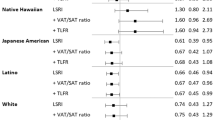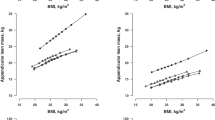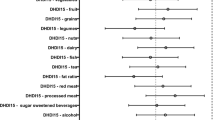Abstract
Background/objective
As dietary intake and endocrine metabolism are vastly different by sex, we evaluated differences in the association of diet quality with body composition between men and women.
Subjects/methods
Close to 2000 participants from the Multiethnic Cohort completed calibrated quantitative food frequency questionnaires at cohort entry (1993–96) and clinic visit (2013–16), from which the Healthy Eating Index (HEI-2010) was computed. Adiposity measures were obtained through DXA and MRI at clinic visit. Multivariable-adjusted mean adiposity measures were estimated by tertiles of HEI-2010 scores using general linear regression. The associations of diet quality with high visceral fat (VAT) and nonalcoholic fatty liver disease (NAFLD) were examined by logistic regression. To assess sex differences, cross-product terms with the HEI-2010 were added to the models.
Results
Mean HEI-2010 scores were higher for women than men at cohort entry (67.4 vs. 64.0) and clinic visit (73.6 vs. 71.0). Past and current diet quality was inversely associated with adiposity measures in men and women. Although interaction terms were not significant, the magnitude of the slopes and differences in adjusted means across tertiles suggested a stronger association for women than men. When comparing individuals who maintained a high vs. poor quality diet over 20 years, women but not men showed significantly lower risks for high VAT, whereas high HEI-2010 scores predicted a lower risk of NAFLD in both sexes.
Conclusions
The inverse association of diet quality with adiposity was similar in both sexes, but diet quality appeared to have a stronger influence on VAT in women than men.
This is a preview of subscription content, access via your institution
Access options
Subscribe to this journal
Receive 12 print issues and online access
$259.00 per year
only $21.58 per issue
Buy this article
- Purchase on Springer Link
- Instant access to full article PDF
Prices may be subject to local taxes which are calculated during checkout

Similar content being viewed by others
References
Lee H, Pak YK, Yeo E-J, Kim YS, Paik HY, Lee SK. It is time to integrate sex as a variable in preclinical and clinical studies. Off J Korean Soc Biochem Mol Biol. 2018;50:1–2.
Lee H, Kang M, Song WO, Shim JE, Paik HY. Gender analysis in the development and validation of FFQ: a systematic review. Br J Nutr. 2016;115:666–71.
Smiciklas-Wright H, Mitchell DC, Mickle SJ, Cook AJ, Goldman JD. Foods commonly eaten in the United States. US Dep Agric NFS Rep. 2002;965:1–264.
Kelly MT, Rennie KL, Wallace JM, Robson PJ, Welch RW, Hannon-Fletcher MP, et al. Associations between the portion sizes of food groups consumed and measures of adiposity in the British National Diet and Nutrition Survey. Br J Nutr. 2009;101:1413–20.
Kang M, Park SY, Boushey CJ, Wilkens LR, Monroe KR, Le Marchand L, et al. Portion sizes from 24-hour dietary recalls differed by sex among those who selected the same portion size category on a food frequency questionnaire. J Acad Nutr Diet. 2018;118:1711–8.
Shiferaw B, Verrill L, Booth H, Zansky SM, Norton DM, Crim S, et al. Sex-based differences in food consumption: Foodborne Diseases Active Surveillance Network (FoodNet) Population Survey, 2006-2007. Clin Infect Dis. 2012;54 Suppl 5:S453–7.
Bates CJ, Prentice A, Finch S. Gender differences in food and nutrient intakes and status indices from the National Diet and Nutrition Survey of people aged 65 years and over. Eur J Clin Nutr. 1999;53:694–9.
Guenther PM, Casavale KO, Reedy J, Kirkpatrick SI, Hiza HA, Kuczynski KJ, et al. Update of the healthy eating index: HEI-2010. J Acad Nutr Dietetics. 2013;113:569–80.
U.S. Department of Health and Human Services, US Department of Agriculture. Dietary Guidelines for Americans 2010. Available from: https://health.gov/dietaryguidelines/2010/. (Accessed 1/21/2020).
Kang M, Park S-Y, Shvetsov YB, Wilkens LR, Marchand LL, Boushey CJ, et al. Gender differences in sociodemographic and lifestyle factors associated with diet quality in a multiethnic population. Nutrition. 2019;66:147–52.
The GBD 2015 Obesity Collaborators. Health effects of overweight and obesity in 195 countries over 25 years. N Engl J Med. 2017;377:13–27.
Mohamed Asrih FRJ. Diets and nonalcoholic fatty liver disease: the good and the bad. Eur Soc Clin Nutr Metab. 2014;33:186–90.
Foster MT, Pagliassotti MJ. Metabolic alterations following visceral fat removal and expansion: Beyond anatomic location. Adipocyte. 2012;1:192–9.
Tchernof A, Despres JP. Pathophysiology of human visceral obesity: an update. Physiol Rev. 2013;93:359–404.
Maskarinec G, Lim U, Jacobs S, Monroe KR, Ernst T, Buchthal SD, et al. Diet quality in midadulthood predicts visceral adiposity and liver fatness in older ages: the Multiethnic Cohort Study. Obesity. 2017;25:1442–50.
Kolonel LN, Henderson BE, Hankin JH, Nomura AMY, Wilkens LR, Pike MC, et al. A multiethnic cohort in Hawaii and Los Angeles: baseline characteristics. Am J Epidemiol. 2000;151:346–57.
Lim U, Monroe KR, Buchthal S, Fan B, Cheng I, Kristal BS, et al. Propensity for intra-abdominal and hepatic adiposity varies among ethnic groups. Gastroenterology. 2019;156:966–75.
Stram DO, Hankin JH, Wilkens LR, Henderson B, Kolonel LN. Calibration of the dietary questionnaire for a multiethnic cohort in Hawaii and Los Angeles. Am J Epidemiol. 2000;151:358–70.
Murphy SP, Wilkens LR, Hankin JH, Foote JA, Monroe KR, Henderson BE, et al. Comparison of two instruments for quantifying intake of vitamin and mineral supplements: a brief questionnaire versus three 24-hour recalls. Am J Epidemiol. 2002;156:669–75.
Harmon BE, Boushey CJ, Shvetsov YB, Ettienne R, Reedy J, Wilkens LR, et al. Associations of key diet-quality indexes with mortality in the Multiethnic Cohort: the Dietary Patterns Methods Project. Am J Clin Nutr. 2015;101:587–97.
Nazare JA, Smith JD, Borel AL, Haffner SM, Balkau B, Ross R, et al. Ethnic influences on the relations between abdominal subcutaneous and visceral adiposity, liver fat, and cardiometabolic risk profile: the International Study of Prediction of Intra-Abdominal Adiposity and its relationship with cardiometabolic risk/intra-abdominal adiposity. Am J Clin Nutr. 2012;96:714–26.
Ellen W, Demerath SSS, Rogers Nikki, Lee Miryoung, Reed Derek, Choh AudreyC, et al. Anatomical patterning of visceral adipose tissue: race, sex, and age variation. Obesity. 2007;15:2984–93.
Bertoli S, Leone A, Vignati L, Bedogni G, Martinez-Gonzalez MA, Bes-Rastrollo M, et al. Adherence to the Mediterranean diet is inversely associated with visceral abdominal tissue in Caucasian subjects. Clin Nutr. 2015;34:1266–72.
Molenaar EA, Massaro JM, Jacques PF, Pou KM, Ellison RC, Hoffmann U, et al. Association of lifestyle factors with abdominal subcutaneous and visceral adiposity: the Framingham Heart Study. Diabetes Care. 2009;32:505–10.
Chan R, Wong VW, Chu WC, Wong GL, Li LS, Leung J, et al. Diet-quality scores and prevalence of nonalcoholic fatty liver disease: a population study using proton-magnetic resonance spectroscopy. PLoS ONE 2015;10:e0139310.
Fischer K, Moewes D, Koch M, Muller HP, Jacobs G, Kassubek J, et al. MRI-determined total volumes of visceral and subcutaneous abdominal and trunk adipose tissue are differentially and sex-dependently associated with patterns of estimated usual nutrient intake in a northern German population. Am J Clin Nutr. 2015;101:794–807.
Ruttgers D, Fischer K, Koch M, Lieb W, Muller HP, Jacobs G, et al. Association of food consumption with total volumes of visceral and subcutaneous abdominal adipose tissue in a Northern German population. Br J Nutr. 2015;114:1929–40.
Jacobs S, Harmon BE, Boushey CJ, Morimoto Y, Wilkens LR, Le ML, et al. A priori-defined diet quality indexes and risk of type 2 diabetes: the Multiethnic Cohort. Diabetologia. 2015;58:98–112.
Aumueller N, Boushey CJ, Franke AA, Cooney RV, Monroe KR, Haiman CA, et al. Diet quality measured by four a priori-defined diet quality indices is associated with lipid-soluble micronutrients in the Multiethnic Cohort Study (MEC). Eur J Clin Nutr. 2019;73:703–13.
Chai W, Maskarinec G, Franke AA, Monroe KR, Park SY, Kolonel LN, et al. Association of serum gamma-tocopherol levels with mortality: the Multiethnic Cohort Study. Eur J Clin Nutr. 2020;74:87–96.
Jacobs S, Boushey CJ, Franke AA, Shvetsov YB, Monroe KR, Haiman CA, et al. A priori-defined diet quality indices, biomarkers and risk for type 2 diabetes in five ethnic groups: the Multiethnic Cohort. Br J Nutr. 2017;118:312–20.
Acknowledgements
We thank the Multiethnic Cohort Study participants who generously donated their time and effort and we acknowledge the excellence performance of the study staff. Funding was provided by the grants from the US National Institutes of Health (P01CA169530, U01CA164973, P30CA071789, #UL1TR000130).
Author information
Authors and Affiliations
Contributions
LLM, UL, and LRW designed the overall research project; CJB developed nutritional support and the diet scores; SDB, TE, and JAS provided essential services in imaging and adiposity measures; LAN, MK, and GM analyzed the data and drafted the paper; LRW provided statistical advice; all authors contributed to data interpretation and critical revisions. GM had primary responsibility for the final content.
Corresponding author
Ethics declarations
Conflict of interest
The authors declare that they have no conflict of interest.
Additional information
Publisher’s note Springer Nature remains neutral with regard to jurisdictional claims in published maps and institutional affiliations.
Rights and permissions
About this article
Cite this article
Maskarinec, G., Namatame, L.A., Kang, M. et al. Differences in the association of diet quality with body fat distribution between men and women. Eur J Clin Nutr 74, 1434–1441 (2020). https://doi.org/10.1038/s41430-020-0563-1
Received:
Revised:
Accepted:
Published:
Issue Date:
DOI: https://doi.org/10.1038/s41430-020-0563-1



